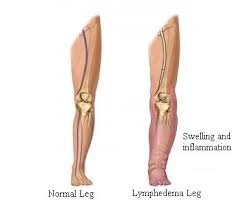What is Lymphoedema?
Lymphoedema is a build-up of protein rich fluid, resulting in swelling of the affected area. While it is most commonly seen in the limbs, it can also occur in the trunk, breasts, head and neck. The appearance of oedema is due to an inability of the lymphatic system to move fluid, either due to increased fluid in the lymphatic system, or due to decreased ability of the lymphatic system to function. If nodes are removed (as is common in cancer treatment) or the system is damaged, congestion occurs, similar to a traffic jam, and fluid becomes backed up.
Lymphoedema can be classified as either primary or secondary depending on its mechanism of onset.
Primary Lymphoedema
Usually present bilaterally in the lower limb, this lyphoedma is caused by a congenital condition where the lymphatic vessels have not developed properly. Some patients never notice any symptoms until being set off by an event, such as an episode of cellulitis or a mosquito bite.
Secondary Lymphoedema
Secondary lymphoedema occurs due to damage to the lymphatic system either by surgery, infection, infiltration of cancer into the lymph nodes, or obstruction. The most well-known cause is due to axillary lymph node clearance for the treatment of breast cancer. However, removal of lower limb lymph nodes may result in lymphoedma of the leg.
Physiotherapy Treatment of Lymphoedema
Education
This is arguably the most important part of treatment and should start with preventative education for patients at high risk of developing lymphoedema. It needs to be emphasised to patients that the condition is progressive in nature and, if left untreated, it will worsen.
Treatment will depend on the severity of the oedema. Patients with established oedema may experience flare ups but they should have several treatment techniques in their tool box to manage swelling independently or with the help of a physiotherapist. Various treatments that may be used include compression garments, lymphatic massage, and skin care. It is also important to track the progression of the lymphoedma, which may be done with circumference measurements.




